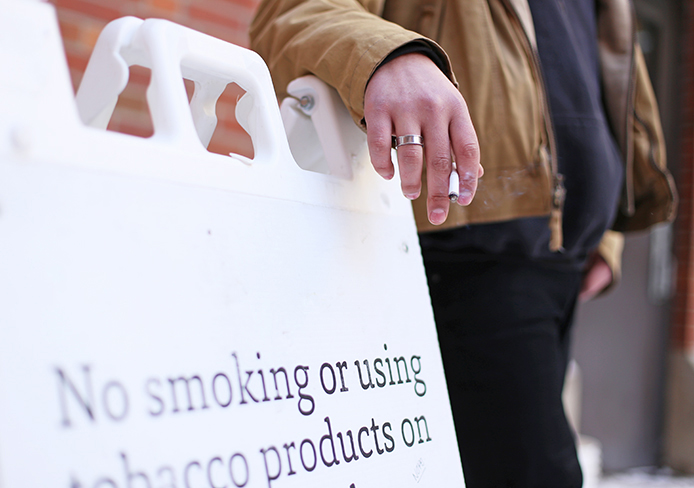
The Ohio State University campus is a smoking and tobacco free zone. Credit: Lantern File Photo
Ohio State is approaching the two-year anniversary of when it enacted the tobacco-free policy, which occurred in January 2014. The policy means no form of tobacco can be consumed, smoked or chewed, by any of its faculty, staff, students, vendors, volunteers or visitors while on campus.
While OSU approaches the two-year mark, the university is included among 1,130 tobacco-free universities, as of Oct. 2, according to Americans for Nonsmokers’ Rights.
“The idea was, let’s send a message to everybody that tobacco use is not okay and it should be denormalized,” said Dr. Peter Shields, a professor of internal medicine at the College of Medicine and deputy director of the OSU Comprehensive Cancer Center. “For me, the greatest impact would actually be around the students.”
Shields said that as most smokers start in adolescence, the habit and addiction is cemented in early adulthood and while in college.
The university’s tobacco free policy makes it harder for smokers to use tobacco on campus, forcing them off campus, and Shields said the hope is that this results in a continuing drop to on-campus use.
However, some Buckeyes might be surprised to hear this policy also includes the use of electronic cigarettes.
Though e-cigarettes have helped certain patients quit smoking, Shields said he believes that there isn’t enough evidence to suggest that e-cigarette users would not become regular smokers later.
“Electronic cigarettes are glorifying the smoking act,” Shields said. “It’s against our culture of what we’re trying to promote. If it turns out that there’s some benefit or lack of harm, then we’ll take it off the policy.”
The tobacco-free status has led Americans for Nonsmokers’ Rights to add OSU to its list of over 1,000 tobacco-free campus.
Micah Berman, an assistant professor at the College of Public Health who also holds a joint appointment with the Moritz College of Law, said that OSU’s addition to the list is significant because it sets an example for smaller schools to follow suit and make their campuses tobacco-free.
“Ohio State was not the trailblazer,” Berman said. “That being said, Ohio State (being added to the list) was big news because of how big (the school is).”
Berman said that because of OSU’s admission to the ANR’s list, it has continued a chain reaction of other Big Ten schools starting the process of becoming tobacco-free.
Not only does this set a good example for schools across the country, but it encourages Ohio schools to revisit their own tobacco policies, said Tessie Pollock, the director of external relations at the College of Public Health.
Pollock noted that Ohio schools have begun to follow the policies OSU has implemented. Columbus State Community College, Miami University and Ohio Dominican University have tobacco-free campuses.
Since the policy was enacted, the university has used signs around campus about the ban and created student ambassadors that help promote the culture of a tobacco-free campus.
There is still a lot more work to be done, Shields said, like setting appropriate benchmarks for the university to figure out how well the policy is being followed.
Ways of doing this include removing ashtrays from campus, holding cigarette butt cleanups and conducting anonymous surveys.
“We’re not getting pushback on this,” Shields said. “We’re not getting people who are upset. We’re not getting fist-fights, and we’re seeing the usage rates go down.”
Amanda Etchison and Michael Huson contributed to this story.


